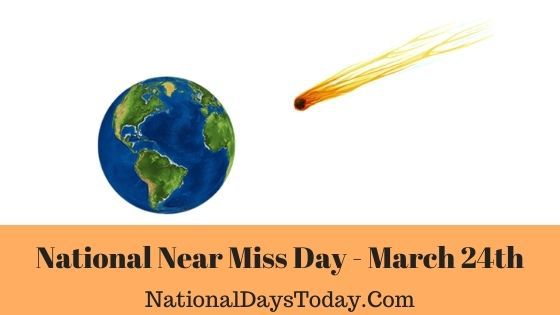National Near Miss Day
National Near Miss Day:
Celebrated annually on 24th March, the National Near Miss Day is celebrated to remember the day in 1989 when an asteroid nearly collided with the Earth. This day honors the concept of second chances in life and is celebrated in different cultures worldwide.
| Year | Date | Day | Where |
| 2022 | 24th March | Friday | United States |
| 2023 | 24th March | Sunday | United States |
| 2023 | 24th March | Monday | United States |
Twitter Hashtags:
#NationalNearMissDay
#NearMissDay
Related: Other National Days Celebrated on March 24th:
National Education and Sharing Day
National Chocolate Covered Raisins Day
Why National Near Miss Day?
It is truly magnificent how far mankind has fared against the many astronomical odds that were presented by the cosmos in history. In its brief history (relative to the cosmos), Earth has seen mass extinction level events in the form of the asteroid that hit the Earth and resulted in the extinction of Dinosaurs.
Such a similar fate could have unfolded on March 23rd in 1989 when a 300-meter-wide asteroid called Asclepius 4581 (based on the Greek Demigod of Medicine) nearly missed the earth by a distance of about 450,000 miles (684,000kms). Experts say that if it were to hit the Earth, the collision itself would have generated an impact equivalent to a 1000 atom bombs! This would have surely led to an apocalypse of sorts, and billions would have perished from existence.
Asteroids are a common sight in the solar system. They are basically a by-product of the formation of the Solar system. These space rocks are mostly found in the asteroid belt between Mars and Jupiter and the Kuyper belt that surrounds our entire solar system and is more than 20 times larger than the asteroid belt. There have been near-misses before, but most of them were isolated events, so not much information is available.
The Asclepius 4581 missing the Earth so narrowly gave the day unusual importance. It literally meant that Earth got a second chance at life. This day tries to celebrate the second chances in life and that nothing is beyond salvation. Our cosmic perspective hit a massive reality check as we realized that Mankind held no power over the cosmos and the mother Earth itself was not invincible. Ever since the day, there was a progressive change in the Space programs of various states. Missions were organized, and ships were launched at the beginning of the 21st century to reach out to nearby planets (and their moons) and study them for factors that could support life. The realization was cold and simple, for the human race to survive, we need to be a space-faring species as our planet is subject to internal and external factors that could very well lead to our extinction one day.
So, use the National Near Miss day to spread this information to people and make them feel how fortunate they are to be still alive. Stretch the importance of living life to the fullest as human life can end within a matter of seconds. Make the second chances count, and don’t give up as there might not be a third chance at life.
How can we observe National Near Miss Day?
- Educate yourself about asteroids:
Head to NASA’s official website and learn about asteroids, explore them and monitor their journey across our line of sight in space through their telescopes.
- Share the story of Near Miss Day:
Read about other near misses and share stories about them. This shall include the one on March 23rd of 1989 and just what could’ve happened to our planet and mankind at large.
- Spread the love:
Share videos and stories by way of pictures and video shorts on social by using the #NationalNearMissDay or #NearMissDay
Interesting Facts on National Near Miss Day:
Here are some interesting facts on asteroids for you:
- Astronomers did not discover the occurrence of Asclepius 4581 till 9 days after it occurred. It was astonishing how most radars and telescopes missed something so significant. Henry Holt and Norman Thomas ultimately found it.
- Ceres is the largest known asteroid.
- William Herschel was the first to coin the term ‘asteroid.’
- A meteoroid about the size of a car falls through the Earth’s orbit once per year on average.
- There are 600,000 asteroids in the solar system.
- Many asteroids are rich in minerals such as iron, lead, and elements that are unknown to science.
- Asteroids don’t have enough gravity to make them spherical in shape.
History of National Near Miss Day:
There is no one specific on record to have coined the National Near Miss Day. It is believed that it might have been a stargazer who came up with the idea to celebrate this day of second chances.


